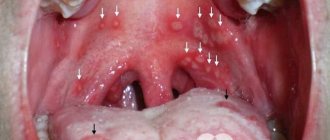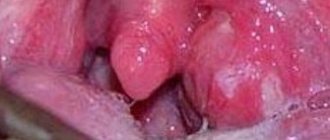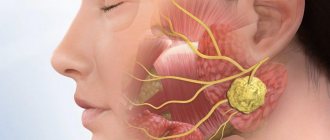Total information
Catarrhal tonsillitis is one of the most common inflammatory pathologies of the palatine tonsils. In this case, not only the tonsils are affected, but also the palatine arches. The hard and soft palate may also become inflamed.
note
The characteristics of the morbidity have changed: previously, like other forms of angina, children of middle and high school age (from 10 to 15 years old) were more likely to get sick, but now the highest morbidity is typical for the age category from 13 to 17-18 years.
Females and males suffer with approximately the same frequency.
Causes
The direct etiological factor in the occurrence of catarrhal tonsillitis is the microflora:
- pathogenic and conditionally pathogenic. Accordingly, this is the one that causes disease under any circumstances, and the one that lives peacefully in the human body, but can demonstrate aggressive properties under certain conditions;
- nonspecific and specific - causing many different pathologies from different organs and the one whose presence is necessary for the occurrence of a certain disease.
In the vast majority of diagnosed cases, the pathogen is nonspecific - that is, one that is capable of causing the development of other types of infectious pathologies in the body - for example, abscess, phlegmon, pleurisy, pneumonia, appendicitis and others.
Most often, with catarrhal tonsillitis, the following are found:
- b-hemolytic streptococcus group A;
- Haemophilus influenzae (or Pfeiffer bacillus).
During repeated bacteriological examination, other pathogens are also isolated, but presumably they join as secondary microflora.
The infection is found in the oropharynx and nasopharynx of all people, but not everyone causes the development of catarrhal sore throat. This is due to the presence of local immunity. On the other hand, for the described disease to occur, certain contributing factors must be present. Most often this is:
- local foci of infectious pathogen;
- tonsil injuries;
- impaired immunity - local and systemic;
- hypothermia;
- inhalation of polluted air.
Catarrhal tonsillitis develops in the tonsils, which have not yet been affected by the inflammatory process, but for its part it develops into tonsillitis such as:
- lacunar - occurs with the expansion of lacunae (natural anatomical depressions in the tissues of the tonsils);
- follicular – develops with a violation of the follicular apparatus of the tonsils.
Typically, the infectious pathogen enters the tonsil tissue from the outside, but local foci of infection can also be its “supplier”. Most often they occur in infectious pathologies:
- teeth;
- language;
- lips;
- oro- and nasopharynx.
As a rule, these lesions are formed in diseases and pathological conditions such as:
- caries - destruction of the hard tissues of a part, which in turn occurs due to the loss of minerals and salts (it is also called demineralization) and the destruction of its organic matrix (base);
- periodontal disease – deep damage to the tissues around the tooth;
- pathological eruption of wisdom teeth;
- traumatic damage to a tooth – due to external and medical injuries.
Usually, superficial trauma to the tonsils is enough for the infection to penetrate them and cause the development of the inflammatory process. The causes of such damage are:
- foreign body injury;
- consuming hot or cold food or drinks;
- too high and/or too low temperatures - against their background, microcracks of the palatine tonsils appear;
- injury during medical procedures;
- regular inhalation of atmospheric air contaminated with harmful aggressive substances
and others.
Factors that do not provoke the occurrence of catarrhal tonsillitis, but contribute to its occurrence, have also been studied. This:
- general hypothermia;
- drinking alcohol;
- smoking;
- malnutrition – including with the development of hypovitaminosis (lack of vitamins);
- endocrine diseases;
- tumors;
- immunodeficiencies;
- a number of medications.
With general hypothermia, the risk of catarrhal tonsillitis increases several times, even if local hypothermia was not observed.
note
Alcohol irritates the tonsils and contributes to the formation of microcracks in them, which increase and become accessible to the penetration of microflora.
Why does smoking contribute to the development of catarrhal tonsillitis? Firstly, cigarette smoke irritates the mucous membrane of the tonsils and contributes to the disruption of its integrity. Secondly, nicotine constricts blood vessels, and this ultimately leads to a deterioration in blood flow, causing tissue repair to deteriorate.
With improper nutrition, the trophism of the tonsils is disrupted, their tissues do not receive additional proteins, fats, vitamins, minerals and vitamins, which is why their reparative ability deteriorates.
Of the endocrine diseases against which the described pathology develops more often, the greatest role is played by:
- diabetes mellitus – a disorder of carbohydrate metabolism due to a deficiency of the hormone insulin;
- hypothyroidism – lack of thyroid hormones;
- hyperthyroidism – their excessive amount.
The connection between catarrhal tonsillitis and malignant diseases is only being studied, but it has been established that against the background of such damage to the oro- and nasopharynx, catarrhal tonsillitis occurs more often.
Congenital and acquired immunodeficiencies lead to activation of microflora.
note
Of the medications, chemotherapy and corticosteroids contribute to the occurrence of catarrhal tonsillitis.
Causes of catarrhal tonsillitis
Like any other inflammation of an infectious nature, catarrhal tonsillitis occurs under the influence of pathogenic microflora. Among the main causative agents of the disease are:
- Bacterial infection , which is most often represented by group A beta-hemolytic streptococcus, as well as staphylococci, meningococci or pneumococci.
- Viruses , among which the main role in the development of the disease is given to adenoviruses, influenza and ARVI pathogens.
- Fungi and spirochetes , activation of which occurs mainly against the background of immunodeficiency or long-term use of antibacterial drugs.
Regardless of the causes of catarrhal tonsillitis, the disease spreads by airborne droplets. Less commonly, its development is facilitated by a person’s everyday contact with the source of infection when using his personal hygiene items, dishes, etc.
In addition, there are a number of factors that, to one degree or another, contribute to the main causative agents of the pathological process in its occurrence:
- General and local hypothermia of the body.
- Reduced immune resistance of the body to pathogenic microflora or opportunistic microorganisms.
- A person has chronic diseases in the nasopharynx or caries.
- Frequent contacts with infectious patients.
Development of the disease
The described disease occurs as a primary pathology.
The infectious agent can enter the tonsil tissue in the following ways:
- when inhaling infected air;
- with contaminated food;
- with blood and/or lymph flow.
In the oropharynx and oral cavity, at the “junction” of which the palatine tonsils and palatine arches are located, favorable conditions can be created for the reproduction and growth of pathogenic microflora, which causes the development of the described disease. Local stable temperature, general humidity, the presence of a nutrient medium in the form of saliva, bloody discharge from the gums, and food debris are favorable conditions for the presence of infectious pathogens in them.
A certain role in the occurrence of the described disease is played by the so-called Weber's glands - salivary glands located in the thickness of the tongue along its back surface. The saliva produced in them washes away waste products from the tissues of the pharynx and does not allow them to accumulate, creating a favorable environment for the proliferation of microorganisms. If the ducts of these glands become clogged, then the products of tissue metabolism (metabolism) accumulate in the oral cavity and on the walls of the oropharynx, which is a separate “bonus” for the microflora.
The catarrhal process, which develops in the tissues of the palatine tonsils and arches, is the least unfavorable disorder in its manifestations. In this case, all the classic signs of inflammation occur:
- hyperemia - redness;
- swelling (usually the loose lymphoid tissue of the glands swells);
- increased production of exudate by local glands.
Catarrhal tonsillitis is less prone to recurrence (re-occurrence) than other forms of inflammatory lesions, but recently, due to unfavorable factors (polluted air, decreased immune defense of the body, and so on), they have begun to appear more and more often in people who have at least once suffered from this form of damage to the tonsils.
Symptoms of catarrhal tonsillitis in children and adults
The clinical picture of catarrhal tonsillitis includes signs:
- local;
- are common.
Local manifestations of the described disease are:
- pain;
- sore throat;
- feeling of dryness;
- sensation of the presence of a foreign body;
- discomfort when swallowing;
- discomfort during talking, screaming, laughing, sneezing, coughing;
- bad breath;
- speech distortion.
The characteristics of pain will be as follows:
- by localization - in the oropharynx (throat);
- by distribution - there is no objective irradiation, but if the pathology progresses, there may be a feeling that the pain is spreading to the neck area like a collar;
- by nature - sharp, piercing;
- in terms of severity – at first moderate, then intensifying;
- by occurrence - pathologies appear on the very first day, then do not disappear, intensifying when trying to swallow solids, liquids and even one’s own saliva, as well as in the case of moving the tongue.
A sore throat and a feeling of dryness occurs due to drying out of the mucous membrane, which, in turn, appears due to the inflammatory process in the mucous membrane. The feeling of a foreign body appears for the same reason.
Discomfort when swallowing occurs due to the fact that food irritates the inflamed surface of the tonsils.
note
Unpleasant sensations during various actions (laughter, conversation, etc.) appear due to tension on the surface of the tonsils.
Bad breath with catarrhal tonsillitis rarely appears. It most often indicates the transformation of the catarrhal process into a purulent one.
Speech distortion is observed when there is a pronounced inflammatory process in which the root of the tongue is involved, because of this the patient cannot fully use the tongue for articulation (formation of sounds).
The general condition of catarrhal tonsillitis may suffer if intoxication syndrome has developed. This is observed with pronounced progression of catarrhal tonsillitis. Signs such as:
- hyperthermia – increased body temperature. Usually it is not expressed and reaches 37.5-38.0 degrees Celsius, although it can rise higher;
- general weakness;
- lethargy;
- feeling overwhelmed;
- sleep disturbance;
- headache;
- deterioration of appetite, and then its absence.
Symptoms and signs of catarrhal tonsillitis
The duration of the incubation period for catarrhal tonsillitis depends primarily on the general condition of the body, on the activity of the immune system, but the time period after which the disease manifests itself with clinical symptoms ranges from approximately several hours to (maximum) four days.
The disease almost always begins acutely; among the very first symptoms that bother the patient are dryness and sore throat and pain when swallowing. An intoxication syndrome is also characteristic, manifested by aches throughout the body, weakness, headaches, and an increase in temperature from low-grade to febrile and even higher is almost always recorded. However, catarrhal tonsillitis without fever also occurs; however, this variant of the course of the infection is recorded quite rarely. Characteristically, the lymph nodes located on the neck are enlarged, they become denser and when palpated they are painful, but this symptom is not always detected during examination.
Acute catarrhal tonsillitis differs from a disease such as viral pharyngitis in the absence of nasal congestion, which is quite important when carrying out differential diagnosis. The catarrhal form of tonsillitis manifests itself to its maximum during the first 3 days of the disease, and then the symptoms begin to gradually fade.
Catarrhal sore throat without fever, despite the absence of one of the constituent signs of infection, also bothers the patient for 4-5 days.
When examining the patient’s oral cavity, an inflammatory reaction in the area of the tonsils is immediately noted in the form of redness and swelling, which covers their entire surface, equally on both sides. It is also characteristic that the back wall of the pharynx is not hyperemic; the soft palate remains unaffected, in contrast to the palatine arches, which, like the tonsils, are often bright pink when examined. The catarrhal form of tonsillitis is characterized by the absence of any plaque on the tonsils, inclusions of pus, only hyperemia and swelling. It should be remembered that catarrhal tonsillitis in adults, when examined, looks exactly the same as when examined in children. The only difference is the severity of the disease, since in children it is always quite serious.
A rather dangerous complication can be infection of a pregnant woman with catarrhal tonsillitis. It should be borne in mind that if it occurs at any stage of pregnancy, it is very dangerous for the woman, as well as for the unborn child. Therefore, you should consult a doctor immediately.
Thus, the catarrhal form of sore throat is manifested by the following symptoms:
— An abrupt onset with developing symptoms of intoxication, represented by weakness, headache, aches throughout the body;
— The temperature rises to a maximum of 39°C, however, do not forget that there is such an option as catarrhal tonsillitis without fever;
- Development of symptoms such as sore throat, as well as sore throat when swallowing saliva, drinking, eating;
- Concomitant enlargement of the lymph nodes located in the neck;
— Detection during examination of only bright hyperemia of the tonsils and palatine arches without the presence of any purulent plaques;
— Acute catarrhal tonsillitis is also characterized by the development of significant bilateral swelling of the tonsils.
Complications of catarrhal tonsillitis can develop not only in case of untimely seeking of qualified help or improper treatment, but also in case of significant disruptions in the functioning of the protective immune system of an adult or child, when a full-fledged protective reaction of the body in response to a foreign pathogen is not formed and the body is unable resist him. All developing complications are quite serious in their impact on the body and when diagnosing catarrhal tonsillitis, even despite the absence of fever or minor sore throat, their possibility of manifestation must be taken into account and all medical prescriptions must be strictly followed.
Complications of catarrhal tonsillitis are represented by the direct impact of streptococcus, namely its toxins, on the human body, and can manifest themselves in the following pathologies:
- influence on the heart muscle, its damage and the possible development of acute rheumatic fever, which can sometimes bother a person for a very long time;
- damage to the urinary system, namely the kidneys with the development of glomerulonephritis, and in the most severe situations, renal failure;
- damage to the brain system with the development of meningitis;
- the formation of abscesses of the pharyngeal space, which can only be treated in a hospital hospital with surgical intervention;
— one of the most dangerous and also severe complications of angina is sepsis, which can lead to the death of the patient;
- phlegmonous lesion of the cervical space;
- development of laryngitis, otitis.
- damage to the lymph nodes with the formation of complications such as lymphadenitis.
A frequent complication of catarrhal sore throat is its transition to other forms, for example, follicular or lacunar.
Quite often, the main cause of complications in patients infected with catarrhal tonsillitis is considered to be their insufficient attention to their health, failure to consult a doctor for treatment, or failure to comply with the basic rules of its treatment. Perhaps this is due to the seemingly relatively mild symptoms of this pathology.
Diagnostics
The diagnosis of catarrhal tonsillitis is made taking into account the patient’s complaints, details of the anamnesis (history of development) of the pathology, the presence of contributing factors that were described above, the results of additional examination methods (physical, instrumental, laboratory).
From the anamnesis it turns out:
- what could, in the patient’s opinion, be the impetus for the occurrence of the described disease;
- how long the patient has been sick;
- how the local and general condition has changed since the onset of the disease.
The results of the physical examination will be:
- on general examination - the general condition is satisfactory, the skin and visible mucous membranes are pale pink;
- during a local examination, the doctor notes that the patient subconsciously holds his hand on his throat;
- upon palpation (palpation) - pain in the submandibular region is detected, enlargement of regional lymph nodes (submandibular and along the back of the neck)
Instrumental research methods that are used in the diagnosis of catarrhal tonsillitis are:
pharyngoscopy - during it, the oropharynx is examined using a spatula and a reflector. An enlargement of the affected tonsils, their swelling, a shift to the midline of the oral cavity, and sometimes an unexpressed plaque that is easily removed are detected. In addition to changes in the tonsils, there is deviation and swelling of the uvula, thickening of the anterior arch, often its bulging, redness and swelling of the tissues of the pharynx;
- endoscopic examination - it is performed using a clinical endoscope, which is used in otorhinolaryngological practice. The method is used to understand the condition of oropharyngeal tissues that are not visualized by pharyngoscopy;
- Posterior rhinoscopy - examination of the nasal passages using a mirror. The method is used to assess the condition of tissues adjacent to the tonsils.
Laboratory research methods that are used in the diagnosis of catarrhal tonsillitis are:
- general blood test - a moderate or marked increase in the number of leukocytes (leukocytosis) and ESR is detected; as the pathology progresses, a shift in the leukocyte formula to the left may be detected;
- bacterioscopic examination - a smear from the throat and a scraping from the palatine tonsils are examined under a microscope, the pathogen that led to the development of the described disease is identified;
- bacteriological examination - a smear from the throat and a scraping from the tonsils is inoculated onto nutrient media, colonies are expected to grow, and the infectious agent that caused the disease being described is determined from them. Using this method, the sensitivity of the pathogen to antibacterial agents is also determined.
Patient Questions
Question: How contagious is sore throat? Answer: This is a highly contagious infectious disease. Its contagiousness increases in conditions of a close team and close communication (one family, kindergarten, school). A decrease in natural defenses and other factors contribute to the development of the disease.
Question: Is it possible to drink alcohol if you have a sore throat? Answer: For this disease, the patient usually takes antibiotics, which affect the liver. Drinking alcohol has a toxic effect on the liver, which can lead to the development of serious complications.
Question: How long should you take medicine for a sore throat? Answer: To completely destroy staphylococcus, at least 10 days of taking antibiotics are required. The course of treatment is selected by the doctor, taking into account the severity of the process and the patient’s condition.
Catarrhal tonsillitis is a serious pathology, which, if left untreated, can develop into a more severe form or cause the development of severe complications. Treatment should be supervised by a specialist and include taking medications and following a regimen.
Differential diagnosis
Differential (distinctive) diagnosis of catarrhal tonsillitis is usually carried out with such diseases and pathological conditions as:
- the initial stage of development of phlegmonous sore throat;
- retention cyst of the tonsils - a closed cavity with contents accumulated due to a violation of its outflow from the glands;
- tumor of the palatine tonsil;
- the initial stage of development of the toxic form of diphtheria - an infectious pathology provoked by the diphtheria bacillus, in which specific films accumulate in the oropharynx.
Therapeutic measures
Treatment of catarrhal tonsillitis can be carried out both in a hospital setting and at home. It all depends on the severity of the pathological process. It is important to follow the following rules and principles of treatment:
- strict adherence to bed rest. This will not only help the patient get back on his feet faster, but will also reduce the likelihood of progression of sore throat complications such as rheumatism, myocarditis, meningitis, etc.;
- drinking enough fluid. It is better to give preference to jelly, compote, herbal infusions and clean water. Carbonated drinks are not recommended;
- avoid smoking and drinking alcoholic beverages;
- dieting. Sour, fried, smoked and fatty foods are excluded from the diet;
- infected children and adults should be immediately isolated from people around them as soon as they show the first symptoms of the pathology.
Treatment of catarrhal tonsillitis in children and adults is carried out using:
Inhalation for catarrhal sore throat
- antipyretic pharmaceuticals are prescribed for severe hyperthermia;
- antibiotics. This group of drugs is prescribed to both adults and children after the pathogen is identified. Penicillin antibiotics are usually preferred;
- inhalation. Help eliminate unpleasant symptoms of pathology - reduce swelling, hyperemia and pain;
- gargling with products containing antiseptic substances;
- sprays with active ingredients for topical use;
- applying a special warming compress;
- lubricating the throat. In order to remove mucus and purulent secretions (if present) from the surface of the tonsils and mucous membrane of the throat, solutions of Lugol and chlorophyllipt are prescribed.
Complications
Catarrhal tonsillitis may be accompanied by complications such as:
- phlegmonous tonsillitis – purulent-inflammatory lesion of the palatine tonsils;
- stomatitis is an inflammatory lesion of the mucous membrane that lines the oral cavity;
- edema of the pharynx - swelling of its tissues, which can lead to a narrowing of its lumen and thereby interfere with the act of breathing;
- laryngeal edema - swelling of its tissues, which leads to a narrowing of the airway;
- otitis – inflammatory lesion of different parts of the ear;
- lymphadenitis - an inflammatory process in the lymph nodes;
- lymphangitis is an inflammatory process in the lymphatic vessels;
- rhinitis – inflammation of the mucous membrane of the nasal passages;
- sinusitis is an inflammatory lesion of the mucous membrane lining the paranasal sinuses;
- Rhinosinusitis is a combined inflammatory lesion that simultaneously involves the mucous membranes of the nose and its paranasal sinuses.
Secondary complications of the described disease may also occur, most often such as:
paratonsillar abscess - a limited abscess that forms in the form of a closed cavity in the tissues located around the tonsils;
- phlegmon of paratonsillar tissue - its diffuse purulent inflammation, which has no definite boundaries;
- peripharyngeal abscess - a limited abscess that can occur in any of the walls of the pharynx;
- phlegmon of the neck - diffuse purulent lesion of its soft tissues;
- Thrombophlebitis of the cavernous sinus is an inflammatory lesion and blockage by a thrombus (blood clot) of the splitting of the dura mater, which exists normally;
- meningitis - an inflammatory process in the meninges;
- encephalitis - inflammatory damage to brain tissue;
- sepsis is the spread of infection through the bloodstream throughout the body and the formation of secondary foci in various organs and tissues.
As the described disease progresses, in addition to septic complications, non-infectious complications may also arise:
- asphyxia (suffocation) – inability to inhale and exhale. In this case, it occurs as a result of reactive edema of the pharynx and larynx;
- bleeding - the release of blood from the lumen of blood vessels, which is observed due to the fact that the wall of the blood vessel can be destroyed against the background of the inflammatory process;
- aspiration of blood - its entry into the respiratory tract. It occurs against the background of arrosive bleeding;
Treatment of catarrhal tonsillitis in children and adults
Unexpressed catarrhal tonsillitis is treated on an outpatient basis. If the patient's condition worsens, he should be hospitalized in an otolaryngological hospital.
Treatment for this happens:
- non-invasive (conservative);
- invasive.
In turn, conservative treatment is:
- general;
- local.
The basis of treatment is the following:
- antibacterial agents - first, broad-spectrum antibiotics are prescribed, then, depending on the results of the bacteriological research method;
- non-steroidal anti-inflammatory drugs (NSAIDs) - to relieve inflammation in the affected tonsils;
- immunostimulants – to strengthen the body’s natural defenses;
- desensitizing agents - they weaken the effect of pathogen toxins on the body;
- vitamin complexes - in the form of injections, since the patient refrains from excessive swallowing due to pain;
- infusion therapy – carried out for detoxification purposes. The patient is given intravenous drips of saline solutions, electrolytes, protein preparations, glucose, blood serum, and so on.
Local treatment consists of:
- gargling with antiseptic drugs;
- irrigating the throat with them.
Important
Surgical (invasive) treatment is carried out after the acute effects of the described disease have been stopped. In particular, the issue of removing the palatine tonsils is being resolved - in the event that catarrhal tonsillitis has recurred more than once, and various complications have arisen - primary and secondary.
Diagnosis and treatment of the disease
The diagnosis is made based on a survey and external examination of the patient. To confirm it, you will need to take a general blood and urine test, and to exclude other diseases, a swab from the throat.
In order for the treatment to be quick and successful, the doctor may prescribe a study of the sensitivity of the microflora to antibacterial drugs (some antibiotics do not act on microorganisms that are resistant to them). The study can be laboratory or carried out using a special test.
Methods of treating the disease
Treatment of catarrhal tonsillitis is carried out on an outpatient basis (at home).
In order to ensure the fastest recovery, you need to:
- provide the patient with physical and psychological rest;
- ventilate the room in which the patient is located (he must be absent during ventilation) at least twice a day;
- carry out wet cleaning daily;
- humidify the air in the room;
- change underwear during a fever;
- follow a dairy-vegetable diet (it is advisable to give the patient pureed dishes).
Therapy for this disease includes two directions - antibacterial (antibiotics) and local treatment.
The use of antibiotics for sore throat
Antibiotic therapy for catarrhal tonsillitis should be selected by a doctor, based on the clinical picture of the disease and the individual characteristics of the body. It should be noted that some people have an allergic reaction to a certain series of antibiotics; for them, drugs are selected after allergy tests.
For catarrhal sore throat, the following are most often prescribed:
- penicillin drugs - penicillin, bicillin, flemoxin, amoxicillin.
- broad-spectrum antibiotics - ceftriaxone, cephalexin, azithromycin, cefazolin, amoxiclav.
Local treatment of sore throat
For local therapy the following are used:
- Gargling with antiseptic solutions - chlorhexidine, chlorophyllipt, dioxidin, furatsilin.
- Rinsing with decoctions of medicinal plants - a decoction of chamomile or calendula flowers is most suitable for relieving the inflammatory process.
- The use of local anti-inflammatory drugs - to relieve pain and inflammation in the throat, use lozenges (Dr. Mom, Rinza, Septolete), tablets (Trachisan, Amoxiclav), sprays (Cameton, Ingalipt, Lugol).
Features of the course and treatment of catarrhal tonsillitis in children
Catarrhal tonsillitis in children has more pronounced clinical manifestations; it can be accompanied by a high, sharp rise in body temperature, causing the development of seizures. A whitish, easily removable film appears on the tongue, leaving no inflamed surface.
In children of preschool and primary school age, catarrhal tonsillitis in some cases occurs without an increase in body temperature, which makes its symptoms similar to a common cold. In this case, the lack of adequate treatment can lead to the development of complications.
When a diagnosis of catarrhal tonsillitis is made in children attending children's groups, you can be sure that the child became infected in class or kindergarten. When treating this pathology, bed rest is necessary; the choice of drugs should be entrusted to the doctor. Among home remedies, it is possible to use decoctions of medicinal plants for gargling, which should be used after consultation with a specialist.
Features of the course and treatment of catarrhal tonsillitis during pregnancy
As a result of decreased immunity during pregnancy, a woman becomes overly susceptible to airborne diseases of the upper respiratory tract. The occurrence of catarrhal tonsillitis at any stage of pregnancy is dangerous with the risk of complications.
Treatment of a pregnant woman must be treated with special care; it is not advisable to take antibiotics during this period (they can have a negative effect on the development of the fetus). The question of prescribing antibacterial therapy is decided by the doctor if the health of the expectant mother is at risk and only if the benefit to the woman outweighs the risk to the unborn child.
Prevention of the development of catarrhal tonsillitis is a nutritious diet, an active lifestyle and prevention of hypothermia in the autumn-winter period. When the first clinical manifestations of the disease appear, you must visit or call a doctor at home.
Author : Elena Selezneva, Specially for moylor.ru
Prevention
Methods for preventing catarrhal tonsillitis are:
- elimination of pathogenic microflora in the body - in the form of any infectious foci;
- avoiding situations that may be fraught with tonsil injuries;
- strengthening immunity - local and systemic;
- avoiding hypothermia, inhaling polluted air, consuming hot or cold food or drinks, staying in conditions that are too high and/or too low temperatures - against this background, microcracks of the palatine tonsils occur;
- Accurate performance of medical procedures;
- giving up bad habits - drinking alcohol and smoking;
- proper balanced nutrition;
- prevention, diagnosis and treatment of endocrine diseases, tumors, immunodeficiencies;
- avoiding the use of a number of medications that may lead to disorders of the palatine tonsils, contributing to the development of the described disease.
Forecast
The prognosis for catarrhal tonsillitis is generally favorable. The patient recovers completely if the disease described is diagnosed on time and adequate treatment is prescribed without delay. But you should remember the possibility of relapses. They do not appear “out of the blue” - usually the palatine tonsils are compromised.
The prognosis worsens in cases such as:
- older age;
- neglected state;
- development of complications.
Kovtonyuk Oksana Vladimirovna, medical observer, surgeon, consultant doctor
just today
( 45 votes, average: 4.29 out of 5)
Nasal rinses: a review of medications
Lacunar tonsillitis: why it occurs, how to treat
Related Posts
Catarrhal sore throat: treatment at home
In most cases, catarrhal sore throat is treated at home. For recovery, regular throat antiseptics are carried out using pharmaceutical medications (listed in the previous subheading), and if necessary, decongestants and antibiotics are taken.
Additionally, to quickly relieve inflammation and alleviate the symptoms of catarrhal tonsillitis, you can use the following remedies:
- gargling with a herbal decoction of chamomile, calendula or sage. Method for preparing the decoction: 1-2 tbsp. pour 200 ml of boiling water over the herbs and let it brew;
- gargling with soda and salt (1 tsp per glass of water);
- steam inhalation (inhalation of steam from warm water). To further improve breathing, you can drop a little mint or eucalyptus essential oil into the water;
- warming compress. A cotton-gauze napkin soaked in vodka or diluted alcohol is applied to the throat. Wrap the top with wax paper and a warm scarf and leave overnight. Please note that a compress can only be applied after the acute period of the disease has passed.
It is important! Before starting treatment for catarrhal tonsillitis at home, we recommend that you consult a doctor.











